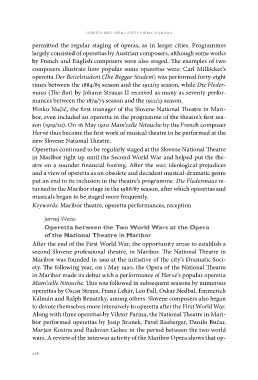Page 570 - Weiss, Jernej, ur./ed. 2021. Opereta med obema svetovnima vojnama ▪︎ Operetta between the Two World Wars. Koper/Ljubljana: Založba Univerze na Primorskem in Festival Ljubljana. Studia musicologica Labacensia, 5
P. 570
opereta med obema svetovnima vojnama
permitted the regular staging of operas, as in larger cities. Programmes
largely consisted of operettas by Austrian composers, although some works
by French and English composers were also staged. The examples of two
composers illustrate how popular some operettas were: Carl Millöcker’s
operetta Der Bettelstudent (The Beggar Student) was performed forty-eight
times between the 1884/85 season and the 1912/13 season, while Die Fleder
maus (The Bat) by Johann Strauss II received as many as seventy perfor-
mances between the 1874/75 season and the 1912/13 season.
Hinko Nučič, the first manager of the Slovene National Theatre in Mari-
bor, even included an operetta in the programme of the theatre’s first sea-
son (1919/20). On 16 May 1920 Mam’zelle Nitouche by the French composer
Hervé thus became the first work of musical theatre to be performed at the
new Slovene National Theatre.
Operettas continued to be regularly staged at the Slovene National Theatre
in Maribor right up until the Second World War and helped put the the-
atre on a sounder financial footing. After the war, ideological prejudices
and a view of operetta as an obsolete and decadent musical-dramatic genre
put an end to its inclusion in the theatre’s programme. Die Fledermaus re-
turned to the Maribor stage in the 1986/87 season, after which operettas and
musicals began to be staged more frequently.
Keywords: Maribor theatre, operetta performances, reception
Jernej Weiss
Operetta between the Two World Wars at the Opera
of the National Theatre in Maribor
After the end of the First World War, the opportunity arose to establish a
second Slovene professional theatre, in Maribor. The National Theatre in
Maribor was founded in 1919 at the initiative of the city’s Dramatic Soci-
ety. The following year, on 1 May 1920, the Opera of the National Theatre
in Maribor made its debut with a performance of Hervé’s popular operetta
Mam’zelle Nitouche. This was followed in subsequent seasons by numerous
operettas by Oscar Straus, Franz Lehár, Leo Fall, Oskar Nedbal, Emmerich
Kálmán and Ralph Benatzky, among others. Slovene composers also began
to devote themselves more intensively to operetta after the First World War.
Along with three operettas by Viktor Parma, the National Theatre in Mari
bor performed operettas by Josip Jiranek, Pavel Rasberger, Danilo Bučar,
Marjan Kozina and Radovan Gobec in the period between the two world
wars. A review of the interwar activity of the Maribor Opera shows that op-
568
permitted the regular staging of operas, as in larger cities. Programmes
largely consisted of operettas by Austrian composers, although some works
by French and English composers were also staged. The examples of two
composers illustrate how popular some operettas were: Carl Millöcker’s
operetta Der Bettelstudent (The Beggar Student) was performed forty-eight
times between the 1884/85 season and the 1912/13 season, while Die Fleder
maus (The Bat) by Johann Strauss II received as many as seventy perfor-
mances between the 1874/75 season and the 1912/13 season.
Hinko Nučič, the first manager of the Slovene National Theatre in Mari-
bor, even included an operetta in the programme of the theatre’s first sea-
son (1919/20). On 16 May 1920 Mam’zelle Nitouche by the French composer
Hervé thus became the first work of musical theatre to be performed at the
new Slovene National Theatre.
Operettas continued to be regularly staged at the Slovene National Theatre
in Maribor right up until the Second World War and helped put the the-
atre on a sounder financial footing. After the war, ideological prejudices
and a view of operetta as an obsolete and decadent musical-dramatic genre
put an end to its inclusion in the theatre’s programme. Die Fledermaus re-
turned to the Maribor stage in the 1986/87 season, after which operettas and
musicals began to be staged more frequently.
Keywords: Maribor theatre, operetta performances, reception
Jernej Weiss
Operetta between the Two World Wars at the Opera
of the National Theatre in Maribor
After the end of the First World War, the opportunity arose to establish a
second Slovene professional theatre, in Maribor. The National Theatre in
Maribor was founded in 1919 at the initiative of the city’s Dramatic Soci-
ety. The following year, on 1 May 1920, the Opera of the National Theatre
in Maribor made its debut with a performance of Hervé’s popular operetta
Mam’zelle Nitouche. This was followed in subsequent seasons by numerous
operettas by Oscar Straus, Franz Lehár, Leo Fall, Oskar Nedbal, Emmerich
Kálmán and Ralph Benatzky, among others. Slovene composers also began
to devote themselves more intensively to operetta after the First World War.
Along with three operettas by Viktor Parma, the National Theatre in Mari
bor performed operettas by Josip Jiranek, Pavel Rasberger, Danilo Bučar,
Marjan Kozina and Radovan Gobec in the period between the two world
wars. A review of the interwar activity of the Maribor Opera shows that op-
568


